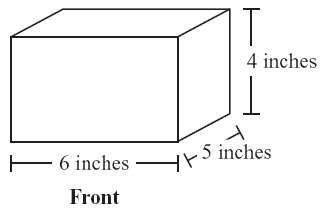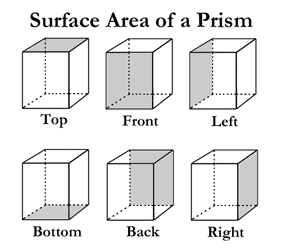Surface area is the total area of the faces of a solid figure. To find the surface area of a prism you must add the area of all of the faces of the given prism. Better yet, you can use the formula:
Surface Area = 2(b•h) + 2(b•w) + 2(h•w)
Example 1:
Find the Surface Area of the following prism –
One way to solve this problem would be to find the area of all the faces and add them all up!
*TIP* You can “unfold” the prism and use a “net” to help you find the measurement of all the sides easier.
Step 1: Find the area of all the faces:
Top- (6 • 5)= 30 sq in
Bottom- (6 • 5)= 30 sq in
Front- (6 • 4)= 24 sq in
Back- (6 • 4)= 24 sq in
Left- (5 • 4)= 20 sq in
Right- (5 • 4)= 20 sq in
Step 2: Add all the face areas together
30 + 30 + 24 + 24 + 20 + 20 = 148 sq in
Another way to solve this problem is to use the formula for surface area.
Step 1: Write the formula for Surface Area
S.A. = 2(b•h) + 2(b•w) + 2(h•w)
Step 2: Substitute the variable with the given information from the problem.
S.A. = 2(6•4) + 2(6•5) + 2(4•5)
Step 3: Solve step by step
S.A. = 2(6•4) + 2(6•5) + 2(4•5)
S.A. = 2(24) + 2(30) + 2(20)
S.A. = 48 + 60 + 40
S.A. = 148 in2

